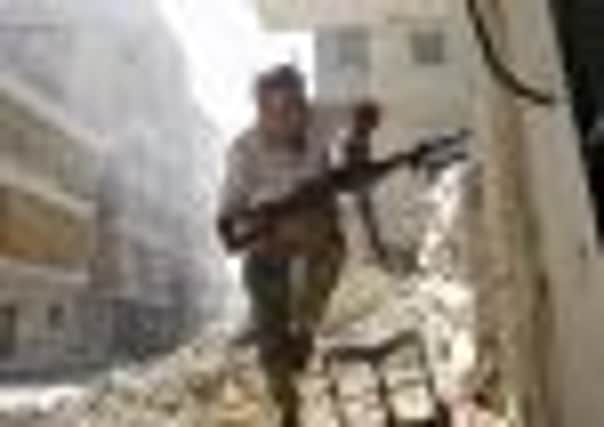Syria: Battle for Aleppo raging on


The intensity of the conflict in Syria’s biggest city and elsewhere suggests that Assad remains determined to cling to power, with support from Iran and Russia, despite setbacks such as this week’s defection of his newly installed prime minister.
“We have retreated, get out of here,” a lone rebel fighter yelled at journalists as they arrived in Aleppo’s Salaheddine district. Nearby checkpoints that had been manned by rebel fighters for the last week had disappeared.
Advertisement
Hide AdAdvertisement
Hide AdSyrian state TV said government forces had pushed into Salaheddine, killing most of the rebels there, and had entered other parts of the city in a fresh offensive. It said dozens of “terrorists” were killed in the central district of Bab al-Hadeed, close to Aleppo’s ancient citadel, and Bab al-Nayrab in the south-east.
The offensive appeared to be the most significant ground attack in Aleppo since rebels seized an arc of the city stretching from the south-east to the north-west three weeks ago. Joma Abu Ahmed, an activist with the rebel Free Syrian Army, said insurgents had fallen back to the nearby neighbourhood of Saif al-Dawla, which was now under fire from army tanks inside Salaheddine and from combat jets.
Some rebels denied retreating and an opposition watchdog, the Syrian Observatory for Human Rights, said fighting in the area was the most violent since insurgents first moved in.
As Assad’s forces battle for Aleppo, there has been no let-up in fighting elsewhere in Syria. More than 240 people were killed on Tuesday, 40 of them in the central city of Homs, the Observatory said.
Aleppo, at the heart of Syria’s failing economy, has taken a pounding since the 17-month-old uprising finally took hold in a city that had stayed mostly aloof from the revolt.
Satellite images released by Amnesty International, obtained from 23 July to 1 August, showed more than 600 craters, probably from artillery shelling, dotting Aleppo and its environs.
“Amnesty is concerned that the deployment of heavy weaponry in residential areas in and around Aleppo will lead to further human rights abuses and grave breaches of international law,” the human rights group said, adding that both sides might be held criminally accountable for failing to protect civilians.
The military’s assaults in Aleppo follow its successful drive to retake neighbourhoods seized by rebels in Damascus after a 18 July bomb attack that killed four of Assad’s closest aides, including his feared brother-in-law Assef Shawkat.
Advertisement
Hide AdAdvertisement
Hide AdOn Monday, Mr Assad suffered the embarrassment of seeing his prime minister, Riyad Hijab, defect after only two months in office. Mr Hijab apparently fled to Jordan with his family. Yet such defections and outside diplomatic pressure seem unlikely to deflect Assad from what has become a bitter struggle for survival between mostly Sunni Muslim rebels and a ruling system dominated by the president’s minority Alawite sect, which is an esoteric offshoot of Shiite Islam.
Mr Assad has firm support from Iran, which sees Syria, along with Lebanon’s Shiite Hezbollah movement, as a pillar of an “axis of resistance” against the United States and Israel.
Syrian rebels, who have accused Iran of sending fighters to help Mr Assad’s forces, seized 48 Iranians in Syria on 4 August, saying they were members of Iran’s Revolutionary Guards.
Iranian foreign minister Ali Akbar Salehi said some of the captives were retired soldiers or Revolutionary Guards who were on pilgrimage to a Shia shrine in Damascus, but he denied they were on active service.
A Syrian rebel spokesman said three of the kidnapped Iranians had been killed in a government air strike and the rest would be executed if the attacks did not stop.